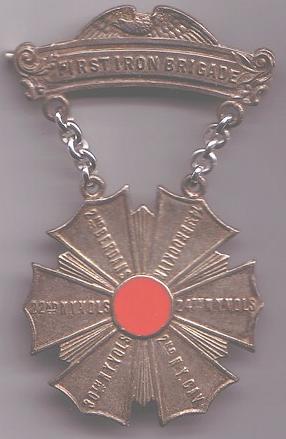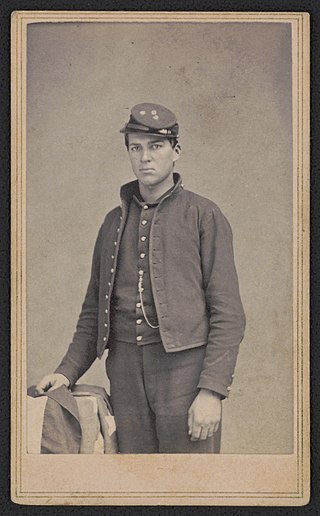
Everton Judson Conger was an American officer during the Civil War who was instrumental in the capture of John Wilkes Booth, the assassin of President Abraham Lincoln, in a Virginia barn twelve days after Lincoln was shot.
The 36th Ohio Infantry Regiment was an infantry regiment that served in the Union Army during the American Civil War. Recruited from several counties in southeastern Ohio, the regiment participated in several battles in the Eastern Theater before being transferred for a period to the Western Theater. In 1864, it returned to the East and participated in the Valley Campaigns of 1864.

The 2nd Wisconsin Infantry Regiment was an infantry regiment that served in the Union Army during the American Civil War. It spent most of the war as a member of the famous Iron Brigade of the Army of the Potomac. It suffered the largest number of casualties as a percentage of its total enlistment of any Union Army unit in the war.

The Veteran Reserve Corps was a military reserve organization created within the Union Army during the American Civil War to allow partially disabled or otherwise infirm soldiers to perform light duty, freeing non-disabled soldiers to serve on the front lines.
The 6th Indiana Infantry Regiment was an infantry regiment from the State of Indiana that served in the Union Army during the American Civil War. This regiment was the senior Indiana regiment of the Civil War, as it was numbered first in sequence after the five Indiana volunteer regiments which had served in the Mexican–American War. The regiment was originally mustered-in for a three-month period of service between April and August 1861, but after its initial term of service had expired it was re-formed in September 1861 for a further three-year period, before being mustered out in September 1864.

The Eastern Iron Brigade, also known as the Iron Brigade of the East and First Iron Brigade, was a brigade of infantry, that served in the Union Army's Army of the Potomac, during the American Civil War. For much of its service, it was designated as the 1st Brigade, 1st Division, I Corps. Among its commanding officers were General John P. Hatch and General Walter Phelps Jr. Noted for its reliability in battle, the brigade developed a reputation which remained after it was disbanded late in the war, due to its annihilation from extremely high casualties.
The 24th New York Infantry Regiment was an infantry regiment in the Army of the Potomac during the American Civil War from the state of New York. It was a part of the famed Eastern Iron Brigade under Colonel Walter Phelps.

Edward Paul Doherty was a Canadian-American American Civil War officer who formed and led the detachment of soldiers that captured and killed John Wilkes Booth, the assassin of US President Abraham Lincoln, in a Virginia barn on April 26, 1865, twelve days after Booth had fatally shot Lincoln.

Andrew J. Lorish was a Commissary Sergeant in the Union Army and a Medal of Honor recipient for his actions in the American Civil War.
New Hampshire was a member of the Union during the American Civil War.

The 88th New York Infantry Regiment was a volunteer regiment in the Union Army's Irish Brigade during the American Civil War.

The 91st New York Infantry Regiment was a state infantry regiment formed during the American Civil War from counties around Albany, New York.

The 118th New York Infantry Regiment was recruited for service in the American Civil War (1861–1865) from Clinton, Essex, and Warren counties in Northern New York. Known as the Adirondack Regiment, the unit saw service along the Atlantic Coast in the Department of Virginia before transferring to the Army of the James in 1864. With the latter, they were engaged in the Overland Campaign and the subsequent siege of Petersburg.

The 1st New York Dragoons Regiment was a cavalry regiment that served in the Union Army during the American Civil War.

The 130th New York Infantry Regiment was an infantry regiment that served in the Union Army during the American Civil War.
The 22nd New York Cavalry Regiment was a cavalry regiment of the Union Army during the American Civil War.

The 1st Regiment New York Mounted Rifles, sometimes designated 7th Regiment New York Volunteer Cavalry, was a cavalry regiment of the Union Army during the American Civil War.
The following list is a Bibliography of American Civil War Union military unit histories. More details on each book are available at WorldCat.

The 1st New York Cavalry Regiment was a regiment in the Union Army in the American Civil War. It was also known as the Lincoln Cavalry, Carbine Rangers, Sabre Regiment, and 1st United States Volunteer Cavalry. It was mustered in from July 16 to August 31, 1861. It was mustered out June 27, 1865.

The 2nd New York Cavalry Regiment, officially known as the 2nd Regiment, New York Volunteer Cavalry, was a unit of the Union Army during the American Civil War. It served with the Army of the Potomac and fought in Stoneman's 1863 raid, the Wilson–Kautz Raid, and the Battle of Appomattox Station.












